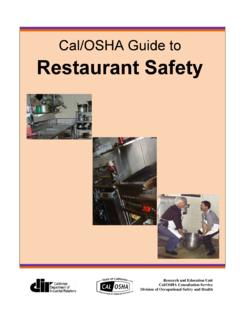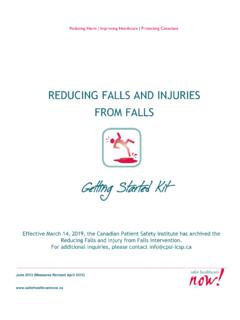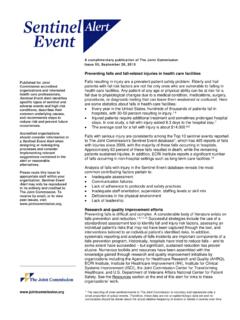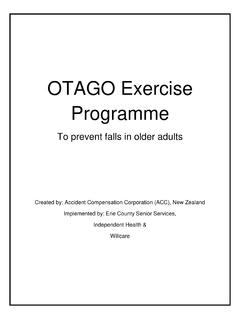Transcription of Part 6 Awareness Raising, Screening and Assessment of …
1 Part 6 Awareness raising , Screening and Assessment of Falls Risk 6. Awareness raising , Screening and Assessment of Falls Risk Measurement of Falls Risk There are a substantial number of falls risk measurement tools that have evidence to support their reliability and validity [132]. However there is at present no tool that can be applied across all settings. Also, of the existing tools few have been validated in more than one setting [133]. In the community setting, there should be available a falls risk tool that can be used with confidence as an initial step to developing an individualised falls prevention program. Consequently, there should be little need to develop new tools.
2 In fact, further development of fall risk tools unique to individual programs/facilities may be counterproductive because scores will not be comparable across programs/facilities [132]. Purpose of Measurement of Falls Risk The purpose of measurement may be: Awareness raising : to examine an individual's Awareness of falls and/or knowledge of risk factors Screening : to determine an individual's level of risk for falls Assessment : to examine an individual's risk factor profile and determine referral pathways and appropriate interventions. Falls Risk Awareness Falls risk Awareness tools are generally designed as an education resource to raise Awareness of risk of falls and alert the person to take remedial action and/or seek professional advice.
3 They often take the form of a checklist with action plan and are self-administered. They may also be used to test knowledge of community-dwelling older people and/or health care workers about falls and risk factors in order Queensland Stay On Your Feet community good practice guidelines 51. to determine the need for, or to evaluate the impact of, an education intervention. (Section provides examples). Falls Risk Screening While there is not a definitive difference between Screening and Assessment tools, Screening is a process that is assumed to be less detailed and may precede Assessment [3]. A falls risk screen is the minimum process to determine which older people are at greatest risk of falling.
4 Typically the screen consists of a small number of items (up to five) based on presence or absence of a risk factor. Since one of the strongest risk factors for falling is having had a previous fall [129], a minimum falls risk screen would be a single item question Have you had a fall in the last 12 months?' Risk factors that form part of a Screening tool may not necessarily be those that can be modified to reduce the risk of falls. When the threshold score on a falls Screening is exceeded it would prompt a more detailed falls risk Assessment . Falls Risk Assessment Falls risk Assessment is a more detailed and systematic process than Screening .
5 It is used to identify modifiable factors that contribute to a person's increased risk of falling and to develop an individualised plan focussed on prevention of falls. The implicit assumption underlying the concept of Assessment of risk is that early detection and intervention (that occurs before overt development of the disorder or adverse event). will lead to a more favourable prognosis or outcome. There is a continuum of falls risk from no risk' through to very high risk'. A graded individual falls risk Assessment provides the opportunity for primary health care professional to identify risk early and intervene before the risk factor has become moderately advanced.
6 Potentially better health outcomes will be achieved through early identification and intervention. 52 Queensland Stay On Your Feet community good practice guidelines Summary of Falls Risk Measurement The circumstances and purpose for which falls risk measurement is undertaken are illustrated in Table Table 6 1: Falls Risk Measurement Tool Who Setting3 Purpose Administers Falls Risk Self- Community to educate and raise Awareness administered Awareness to trigger self-referral to seek professional advice to test knowledge pre-post intervention Falls Risk Health Primary to determine those Screening Professional Health Care at high risk to determine those who warrant more detailed Assessment Falls Risk Health Primary to identify Assessment Professional Health Care modifiable risk factors to target and tailor interventions to implement falls and injury risk management strategies for individuals identified with high risk of fall.
7 3 For community-dwelling older people their first level of care will be in the primary health care setting. See GLOSSARY for definition. Queensland Stay On Your Feet community good practice guidelines 53. General Principles of Screening and Assessment The prevalence of the pre-clinical condition (or risk factors) should be relatively high among the population. If the prevalence of the risk factor is low (or the intervention reaches and changes the risk factors of a limited proportion of the population) there will be little impact at the population level [80]. The resources for conducting risk measurement must be cost effective and the expenses justifiable in terms of ameliorating adverse health consequences.
8 Ethical issues should also be considered such as availability and equity of access for the at-risk population [134]. A suitable test must be available, cost effective, easy to administer, and impose minimal demands or discomfort on those tested. The results must be valid, reliable and reproducible [134]. A number of measurement tools that meet these criteria are listed under Section Effective treatment/interventions/care plans need to be available and evidence-based. There must be a follow-up intervention based on Assessment [134]. Case For and Against Falls Screening and Assessment On the basis of the principles outlined in Section , there is intuitive appeal for falls risk Screening and Assessment as a public health measure.
9 However, there is still debate about its value, particularly for population-based Screening of community-dwelling older people. In support of falls Screening and Assessment All older people should have documentation that they were asked at least annually about the occurrence of recent falls because falls are common, often preventable, and frequently unreported [129, 135]. One of the strongest predictors of a future fall is having a previous fall, but only a third of older fallers report their falls to a health professional [58]. 54 Queensland Stay On Your Feet community good practice guidelines Many previously undetected remediable problems, including falls, can be identified among apparently healthy older individuals in community geriatric Screening programs [136].
10 Multiple falls can be strong indicators of accelerating frailty and the presence of underlying, treatable risk factors [135]. The high prevalence of under- diagnosed and under-treated health-related conditions in older people has motivated the development of specialised geriatric Screening and Assessment programs [137]. Early identification of risk factors allows detection of impairments before a serious injury , secondary deconditioning, or loss of confidence in mobility can occur [58] and relevant changes can be monitored over time [138]. Identification of risk factors provides direction for appropriate referrals and is the cornerstone of most preventing fall programs [63, 139].


















